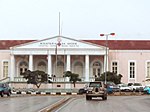Banco de Poupança e Crédito
1956 establishments in AngolaAngolan brandsBanks established in 1956Banks of AngolaCompanies based in Luanda
Banco de Poupança e Crédito (BPC) (English: Savings and Credit Bank) is a government-owned, full service bank in Angola. With some 68 branches, including one in Cabinda, it has the largest branch network in the country.
Excerpt from the Wikipedia article Banco de Poupança e Crédito (License: CC BY-SA 3.0, Authors).Banco de Poupança e Crédito
Rua Reverendo Agostinho Pedro Neto, Luanda Kinanga
Geographical coordinates (GPS) Address Nearby Places Show on map
Geographical coordinates (GPS)
| Latitude | Longitude |
|---|---|
| N -8.8180555555556 ° | E 13.235277777778 ° |
Address
Rua Reverendo Agostinho Pedro Neto
Rua Reverendo Agostinho Pedro Neto
Luanda, Kinanga
Luanda Province, Angola
Open on Google Maps







